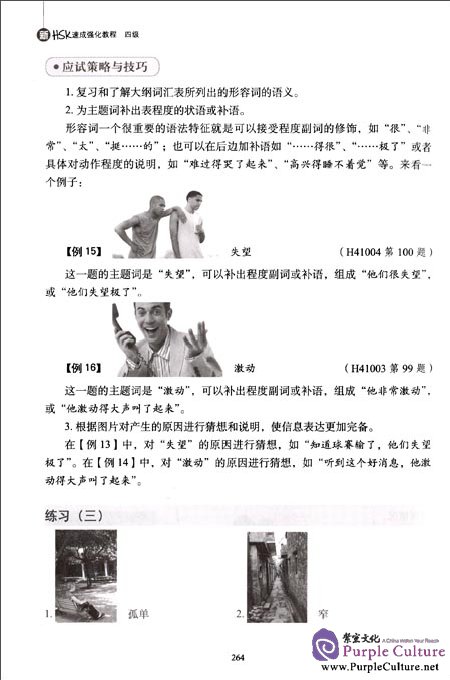Details
Usage Advice
Short intensive training programs (30 class periods for intensive training program or 50~60 class periods for those with supportive exercises); self-taught before the exam
Description
A Short Intensive Course of New HSK, aimed at providing pre-exam guidance and intensive training for the New HSK candidates and training institutions, includes 10 volumes altogether, i.e., the intensive training courses respectively for levels 3~6, the workbooks supporting the intensive courses, the volumes for intermediate spoken Chinese and advanced spoken Chinese. The intensive training course for each level provides two model tests and specific intensive training on the testing points and difficult points about grammar, vocabulary etc., the common errors, and test-taking strategies. The model tests and exercises demonstrate similarity to the official New HSK in difficulty.
This book, written for the New HSK (Level 4) training institutions, candidates and their Chinese teachers, is based on the testing points and difficult points of level 4, illustrating them with examples from the past tests, combining instruction with practice, reinforcing learning through immediate exercises, and making timely summaries so that candidates can make steady progress. It also studies the key words prescribed in the outline of level 4. The book is divided into the following parts: About the Test/Introduction to the Structure/Advice for Users—Model Test 1 (pre-tutorial test so that you’ll find your weak points)—Unit of Listening Comprehension (specific training)—Unit of Reading Comprehension (specific training)—Unit of Writing (specific training)—Model Test 2 (summary, warm-up exercise before the real test).
About the Author(s)
Wang Haifeng, Chen Li and Lu Yun, the authors of this book, are experienced teachers in the School of Chinese as a Second Language of Peking University who have been HSK tutors for many years. A Short Intensive Course of HSK, the original edition of this series they designed for the old HSK, had been ranked as a best seller for a long time in the retail market of Teaching Chinese as a Foreign Language and its cumulative sales had reached nearly 300,000 volumes.
Sample Pages Preview

练习(一)
第1到2题是根据下面一段话:
我经常喝这种饮料。因为它的味道是我喜欢的那种酸酸甜甜的。而且里面又有牛奶又有果汁,对身体很好。有时候来不及吃早饭,我就喝上一瓶,一上午就不饿了。
1.说话人在介绍什么?
2.关于说话人,下面哪个正确?
第3到4题是根据下面一段话:
在平时的生活中,我有一个缺点,就是经常忘东西。昨天我回房间的时候,发现又找不到钥匙了。我只好让服务员帮我把门打开。我一进房间,就看见钥匙在沙发上放着呢。
3.昨天发生了什么事?
4.他主要想告诉我们什么?
第5到6题是根据下面一段话:
小马约了几个亲戚一起吃晚饭。他先给一家有名的饭馆打电话,想要一个包间,服务员说包间都约满了,问他普通的座位行不行,小马拒绝了,他还是想要一个包间,因为他想要安静的环境。小马又给一家饭馆打了电话,才成功要了包间。
5.小马要跟谁吃晚饭?
6.小马为什么要包间?
第7到8题是根据下面一段话:
这件衣服是我前几天整理东西的时候找出来的,两个月前我买的时候还挺合适的,没想到最近又发胖了。这衣服价格不便宜,扔掉也挺可惜的。你看。衣服还是新的,能不能帮我换件大点儿的?
7.说话人是谁?
8.这件衣服怎么了?
练习(二)
第1到2题是根据下面一段话:
我们生活的环境需要我们大家来保护。在我们每天的生活中,如果该减少的减少,可降低的降低,那就是在支持环保。比如说,少用塑料袋,可以骑自行车的时候就不开车,可以用太阳光的时候就不开灯,等等。周围很多朋友都买了车,我却一点儿也不羡慕。
第3到4题是根据下面一段话:
世界上有很多人爱抽烟,也有很多人讨厌抽烟。不抽烟的人一般都受不了烟味儿,甚至见到有人抽烟就马上走开。不过,抽烟的人也许觉得烟味儿比什么味儿都好,有的人可以一天不吃饭,却不能一天不抽烟。
3.这段话主要说什么?
4.说话人对抽烟是什么态度?
